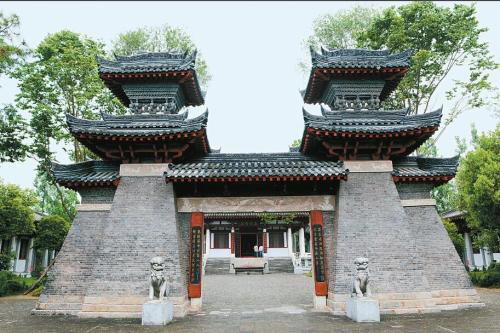- CURRENT LOCATION: HOME
- >> Tourism
- >> Attractions in Cities
- >>
- Hanzhong
Memorial Hall of Zhang Qian
2021-10-20 16:18:00 , Source : The Government Website of Shaanxi Province
The Tomb of Zhang Qian is situated in Raojiaying Village, Chenggu County of Hanzhong in the southwest of Shaanxi Province. It is 19 miles (30 kilometers) east of central Hanzhong, and 132 miles (212 kilometers) southwest of the provincial capital Xi’an. It is the resting place of Zhang Qian, an outstanding diplomat and explorer during the Western Han Dynasty (202BC-9 AD), and the pioneer of the world-famous Silk Road. The tomb, together with the Memorial Hall of Zhang Qian, now holds various precious historical relics for visitors to recall Zhang’s pioneering spirit and exploratory legend. It has been included in the World Cultural Heritage List in 2014 together with other sites along the Silk Road.
Entering the main gate, there is a corridor about 39 feet (12 meters) wide, with two cultural galleries decorated with beautiful pictures of Chenggu’s local cultural customs on both sides of it. At the other end of the corridor stands a Han-styled gate with an arch over the gateway.
On the north of the gateway there is a main hall, which is the axis of the Memorial Hall. There are two paintings inside depicting Zhang’s journey to the Western Regions, roughly including today’s Gansu and Xinjiang in western China, and Central and West Asia. Right by the main hall, there are two wing halls which are used as exhibition rooms.
The east wing hall exhibits the life stories of Zhang Qian (164-114BC). Being an envoy of the Western Han, Zhang traveled twice to the remote Western Regions. His extraordinary contribution to the opening up of the Silk Road greatly enhanced the international communication at that time. He once introduced the Ferghana horse, grape, alfalfa, pomegranate, walnut as well as flax from the Western Regions to central China. After he died in 114 BC, he was buried in his hometown, Chenggu of Hanzhong. The west wing hall exhibits folk art with distinctive characteristics in southern Shaanxi.
To the north of the main hall lies the mausoleum of Zhang Qian. Surrounded by cypress and facing south, it looks like an “A” shape. In front of the tomb, there stand up three stone steles. The one in the middle, with a height of six feet (182 cm) and a width of 2.6 feet (80 cm), is carved with “Tomb of Zhang Qian - Marquis of Bowang in the Han Dynasty”. It was set up by the Shaanxi governor Bi Yuan in Qing Dynasty (1636 - 1912 AD). The one on the left side was set up by the Chenggu County governor Hu Yingtao in Qing Dynasty. It reads “Epigraph for Marquis of Bowang in the Han Dynasty”. The one on the right was erected by Zhang Qian’s offspring.

In front of the stone steles, there is a pair of stone tigers of the Han Dynasty sitting face-to-face. They were made by harsh styles and now can be seen a general profile only. The tigers have been guarded the mausoleum of the national hero for thousands of years. They are seen as divinities for the local people to pray for rain, health and children.
The tomb is composed of three parts, respectively the slope tomb passage, east and west chambers, and main chamber. Since the main chamber had been raided once, lots of historical relics had lost. Only some bronze ware, ironware, pottery, jade articles, and murals are left.
The main features of this tomb are well-preserved, colorful murals in the main chamber. They can be divided into two parts. The first part includes the murals on the roof and the top of the back wall, describing the vision in heaven. The roof is filled with painted floating clouds. On the roof, there are two concentric circles. Between them there painted twenty-eight constellations, and four sacred animals in ancient Chinese myth- Qinglong (blue dragon), Baihu (white tiger), Zhuque (fiery phoenix) and Xuanwu (a combination of turtle and snake), with the sun in the south, and the moon in the north. The painting on the top of the back wall is a derivation graph. In the other part, the bottom of the walls, there are animals like tiger, deer, swan, berghaan, and crane, which describe the sights on earth. The whole painting forms a harmonious view of the coexistence of all livings things in the universe.

Admission Fee | CNY 20 |
Opening Time | 8:30-17:00 |
Transportation | Take coach bus from Hanzhong Bus Station to Chenggu, and then transfer to bus No. 2 to get to the Tomb and Memorial Hall of Zhang Qian. |

Government Organizations



Other Links

Copyright@www.shaanxi.gov.cn All Rights Reserved
Registration Number:陕ICP备10004160号
